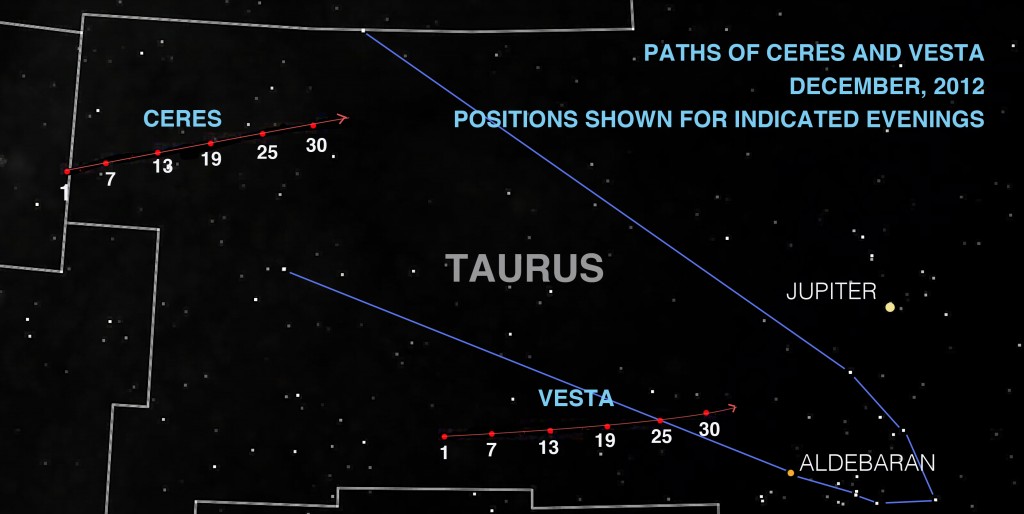![]() LISTEN to this week’s Sky Report
LISTEN to this week’s Sky Report
This is the Griffith Observatory Sky Report for the period ending Wednesday, January 2, 2013. Here is what’s happening in the skies of Southern California:
Winter starts in the northern hemisphere at 3:12 a.m. on Friday, December 21st. This is the shortest day in Los Angeles – 9 hours and 53 minutes long – with the sun appearing between 6:55 a.m. and 4:48 p.m. Winter will last until the start of spring on March 20.
The moon’s phase changes from waxing crescent to first-quarter on the evening of Wednesday the 19th. After that date the moon appears in waxing gibbous phase until the night of the 27th, when it is full. For the remainder of 2012 and the start of 2013, the moon is in waning gibbous phase.
The only obvious bright planet visible in the early evening is Jupiter, in Taurus the Bull. Jupiter starts the evening high in the east, and crosses the meridian, high in the south, four minutes earlier each night, from 10:25 p.m. on the 19th to 9:50 p.m. at on New Year’s day. After crossing the southern sky, Jupiter gradually sinks into the west by dawn. Binoculars will show four star-like points that re-arrange themselves about the planet nightly. These are the Galilean moons. A telescope will also show the patterns of clouds on the face of the planet that help to mark Jupiter’s rapid 9 hour and 55 minute rotation. The moon will appear next to Jupiter on Christmas night.
The largest objects in the main belt of asteroids, dwarf planet Ceres and the asteroid Vesta, remain visible through binoculars at between 6th and 7th magnitude. Both appear close to Jupiter in Taurus the Bull, and can be found with the chart below. NASA’s Dawn mission spacecraft is now en route from Vesta to Ceres.
The ringed planet Saturn is in Libra the Scales and appears about 30 degrees high, a third of the way from the southeast horizon to overhead, at 5:30 a.m., when dawn starts. A telescope will show the north side of the planet’s spectacular ring system tilted 18 degrees in our direction.
The brightest planet, Venus, will still be obvious, low in the southeast, at 6:30 a.m. Now on the far side of its orbit from us, Venus presents a tiny, nearly full disk through a telescope.
The International Space station may make two passes high above Los Angeles on the evenings of Saturday, December 29 and Tuesday, January 1. On the 29th, the space station should outshine Jupiter as it crosses the sky from northwest to southeast between 6:13 and 6:18 p.m., when it vanishes into earth’s shadow while 37 degrees high. From Griffith Observatory, the ISS will appear 79˚ high in the northeast seconds before 6:17 p.m. On the first night of the New Year, the ISS will move from northwest to southeast between 5:18 and 5:25 p.m., and will appear 67 degrees above the southwest horizon at 5:21 p.m. Because the orbit of the ISS can be changed, it is wise to check these positions for updates on the Heavens-Above website, registered for your location.
Free views of the sun during the day and of the moon, planets, and other celestial objects at night, are available to the public in clear weather through Griffith Observatory’s telescopes before 9:30 p.m. Check our website for our holiday schedule. The next Griffith Observatory public star party, hosted by Los Angeles Astronomical Society, the Sidewalk Astronomers, and the Planetary Society, is scheduled for Saturday, December 22.
From Griffith Observatory, I’m Anthony Cook and after January 1, I can be reached at griffithobserver@gmail.com.
